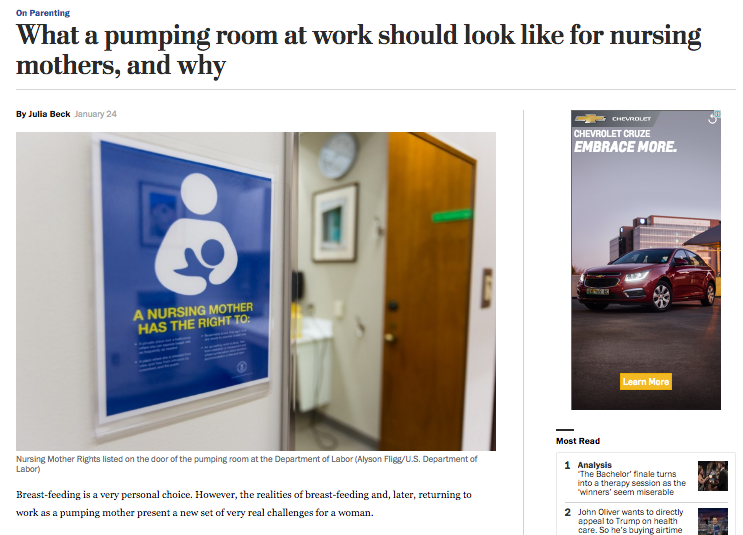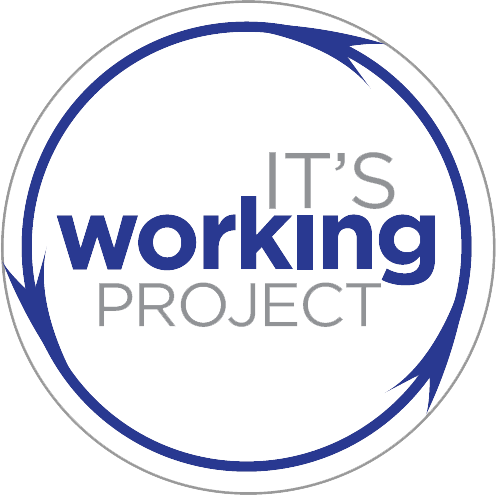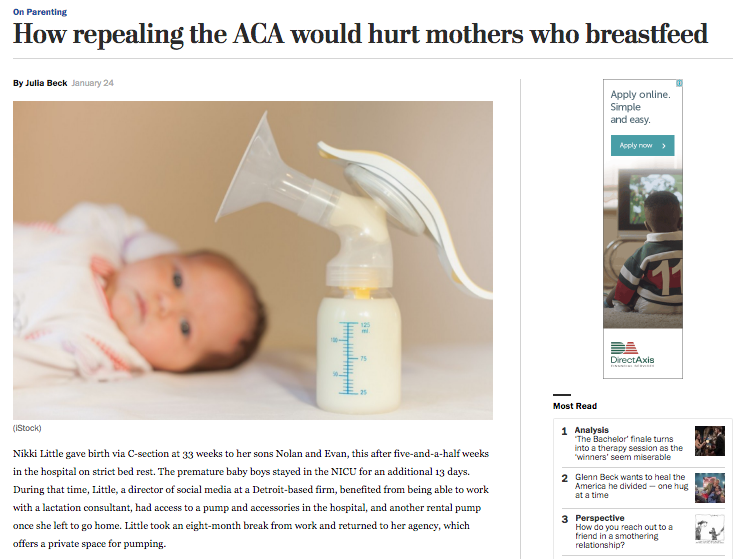This article was originally published in the Washington Post on January 24, 2017

Breast-feeding is a very personal choice. However, the realities of breast-feeding and, later, returning to work as a pumping mother present a new set of very real challenges for a woman.
Workplaces that support a mother in her return to work by bringing her back with ease always win. Committed employers are not only supporting infant health, they are also establishing a powerful statement of collaboration, underscoring how much they value their employee. Although the repeal of the Affordable Care Act might mean organizations no longer legally have to provide the space or time for women to pump at work, many companies know that providing this is not only kind, but also simply a smart business move.Birch Box, for example, offers hospital grade pumps, snacks and a comprehensive booking system for its growing population of mothers in the workplace.
[How repealing the ACA will hurt mothers who breastfeed]
Lauren Pfeiffer was out for 12 weeks after the birth of her second daughter. When she returned to New Jersey-based Association Headquarters, she was greeted with brand new private “mother’s room” that held comfortable seating, a sink, refrigerator, a mirror and even a shared calendar for booking the space. The space made her return to work much more seamless, and the fact that her company set it up made her feel supported and grateful. The room was set up for quiet but also allowed for Pfeiffer to catch up on emails as she pumped breast milk for 20 minutes two to three times a day.
[Did you or do you pump at work? Tell us about your experiences below.]
It is this piece of the puzzle that is my focus at the It’s Working Project. Not only do we gather and share stories of how parents in the U.S. transition back to work, the project also partners with workplaces to help them establish easy-to-execute programs to support working families.
As was the case with Association Headquarters, not only was the pumping room a wise thing for her company to do, but it’s also the law.
Washington D.C. has recently passed legislation and joined 18 states to pass enhanced pregnancy and nursing protections that offer strong protections (and also serious penalties for offenders) for a wide range of workers and situations. Many of these state statutes, including D.C.’s law, also clarify and strengthen the rights of nursing mothers.
“Unfortunately, there is still a tremendous amount of confusion about the rights of pregnant workers,” said Dina Baskt, co-president of A Better Balance, an organization that works with lawmakers to enact legislation to help pregnant and nursing workers. “Thankfully, a growing number of states and localities, including D.C., have stepped in to guarantee pregnant workers a clear, statutory right to reasonable accommodations — the same standard in place for workers with disabilities. Many of these statutes also clarify and strengthen the rights of nursing mothers. Ensuring that pregnant workers and new mothers can avoid the impossible choice between a paycheck and a healthy pregnancy is undoubtedly a win-win for women, families and our economy,” she said in testimony.
But smart businesses are many steps beyond just compliant. “We know it can be a challenging for parents to transition back to work and want to do everything we can to make the transition as smooth as possible,” said Annie Lavigne, human resources director at Edelman Inc. This is “one of the reasons why we are committed to providing a pumping space for nursing mothers that is private, clean, and comfortable. The happier our employees are, the more likely they are to stay. We can’t achieve our business objectives without retaining our talent, and our employee’s ability to manage family and work effectively is a key part of that equation.”
So how do you get what you need at work?
“Employees should emphasize the bottom-line benefits to employers of providing first-in-class benefits to nursing mothers,” advises Baskt. “These programs increase retention and productivity, while also demonstrating the company’s commitment to working families.”
It takes very little for an organization to move from simply compliant to best is class. And the effort and results in a high level of return in the form retention and continued commitment.
What does a pumping room look like anyway?
First, and most critical —
It does NOT look like a bathroom stall, not only is this not legal it is disgusting.
So, what does “compliance” mean:
- Private — NOT A BATHROOM
- Clean — sanitary space
- Close to workspace — not in a separate building or floors away
- Reasonable break times — enough to pump and get milk stored and parts cleaned
And what about best in class:
- Locking Door — BOTH SIDES
- Comfortable Seating
- Clear Surfaces
- Ottoman
- Outlets for pumps
- Sink for cleaning pump parts
- Refrigerator for keeping milk — separate from general staff fridge
- A place where mothers can display images of baby
- Mirror
- Personal storage space
- snacks and water
- sign-up system
We checked around to learn where some of the best pumping rooms could be found:
Julia Beck is the founder of the It’s Working Project and Forty Weeks. Beck is based in Washington, D.C., where she is the matriarch of a blended family that includes a loving husband, a loyal golden retriever and four children — all of whom are her favorite.




